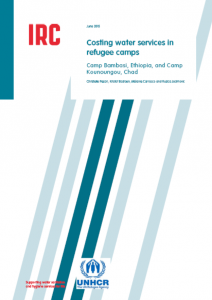
This report applies the life-cycle costs approach (LCCA) to the provision of water services in two UN refugee camps, Bambasi in Ethiopia and Kounoungou in Chad. It is based on cost data from financial reports in Geneva and both camps and on service-level data collected through the UNHCR monitoring system and on site through water point surveys.
The purpose of the study was (1) to better understand the structure, magnitude and drivers of the cost of providing a targeted level of water service to refugees, and (2) to reflect on the applicability of LCCA in the UNHCR monitoring framework and the potential for implementing it in systematically.
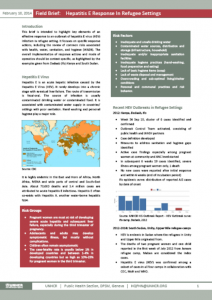
This brief is intended to highlight key elements of an effective response to an outbreak of hepatitis E virus (HEV) infection in refugee setting. It focuses on specific response actions, including the review of common risks associated with health, water, sanitation, and hygiene (WASH). The overall implementation of response actions and mode of operation should be context specific, as highlighted by the examples given from Dadaab (Ifo) Kenya and South Sudan.
Tags: Bulk Water Treatment, Excreta Management, Handwashing with Soap, Household Water Treatment, Hygiene Promotion, Public Health, Water Quality Testing and Surveillance, and Water Safety Plans. Locations: Africa, Dadaab, East and Horn of Africa, Kenya, South Sudan, and Sudan and Chad Special Operational Region. Languages: English. Organisations: UNHCR. Categories: WASH Emergency Guidelines, WASH Guidelines, WASH Operational Guidelines, WASH Policy Guidelines, and WASH Reference Documents.
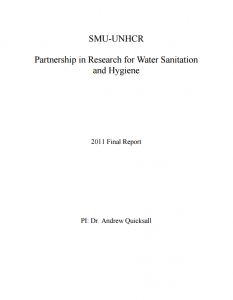
The SMU team conducted five sampling missions to UNHCR refugee camps in Uganda, Kenya, Bangladesh, Djibouti, and Liberia. Overall, these missions were considered a success with 17 camps, 7 villages, and a few additional sites visited. The team collected 213 camp samples and 229 total samples for analyses in the laboratory. Camp conditions and source water characteristics varied widely amongst the five countries but also within the camps themselves.
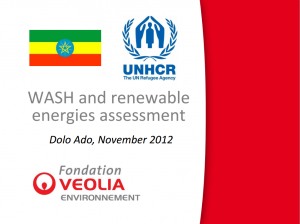
This document looks at drinking water, sanitation and renewable energy solutions and options in three camps in Dolo Odo with recommendations and conclusions.
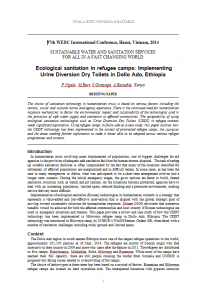
The choice of sanitation technology in humanitarian crisis is based on various factors including the terrain, social and cultural norms and agency experience. There is the continued need for humanitarian response mechanisms to factor the environmental impact and sustainability of the technologies used in the provision of safe water supply and sanitation to affected communities. The acceptability of using ecological sanitation technologies such as Urine Diversion Dry Toilets (UDDT) in refugee contexts needs significant exploration. Using refugee camps in Dollo Ado as a case study, this paper outlines how the UDDT technology has been implemented in the context of protracted refugee camps, the successes and the areas needing further exploration to make it better able to be adopted across various refugee programmes and contexts.
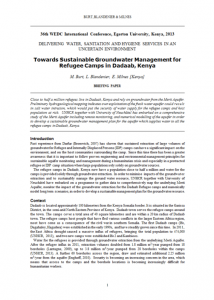
Close to half a million refugees live in Dadaab, Kenya and rely on groundwater from the Merti Aquifer. Preliminary hydrogeological mapping indicates over exploitation of the fresh water aquifer could result in salt water intrusion, which would put the security of water supply for the refugee camps and host population at risk. UNHCR together with University of Neuchâtel has embarked on a comprehensive study of the Merti Aquifer including remote monitoring, and numerical modelling of the aquifer in order to develop a sustainable groundwater management plan for the aquifer which supplies water to all the refugee camps in Dadaab, Kenya.
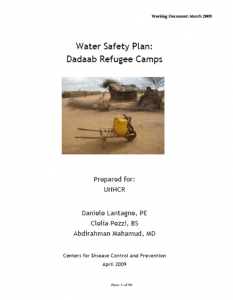
Water safety plan produced by CDC following a technical support visit to Dadaab in 2009. The report contains: An overview of Dadaab water supply system; Identification of hazards and risks; Control measures and prioritisation of risks; Sanitation and hygiene; and Conclusions.
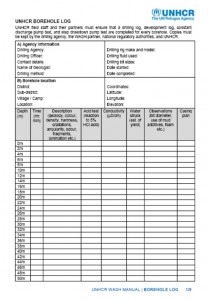
Agency information Drilling Agency: UNHCR Drilling Officer: Mesfin Yagatu Contact Details: yagatu@unhcr.org 7882343 Name of Geologist: Ngusu Atamara Drilling Method: Rotary and DTH Drilling Rig Make and Model: PAT 301 Drilling Fluid Used: Foam Drilling Bit Sizes: 6″ 8″ Date Started: 12/04/2001 Date Completed: 17/04/2001 Borehole location District: Sherkole Zone ‘F’ Sub-district: None Village / […]
 English
English








